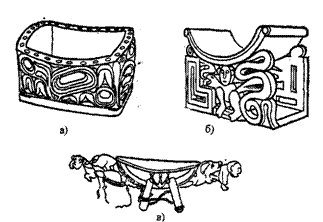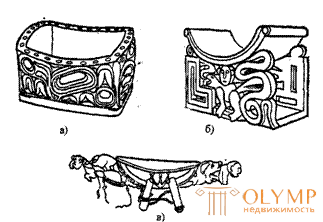
Types of ancient furniture due to the nature of the ancient dwelling. The forms of ancient dwellings can be judged by archaeological excavations, ancient architectural monuments, including tombs, which were considered as the home of a deceased (asleep) person and therefore supplied with household utensils, weapons and food supplies, according to ancient temples, which were understood as a house of deity.
Initially, man lived in natural caves. The history of human dwelling begins with the creation with the help of the simplest tools of labor (sticks, stones) artificial caves and various types of tents and huts. The beginning of this period belongs to the XV-XIII millennium BC, the end to the time of the birth of civilization (in Egypt about the V millennium BC, in Europe - the II millennium BC).
With the development of the future, a sedentary lifestyle appears, and with it a home. The dryest form of a settled house is a round house, which indicates its connection with the tent from which it originated. Later the form becomes rectangular.
The equipment of the most ancient dwelling is connected with the development of foci and a stable bed - the main elements of every dwelling. The outbreak secured and protected man from predators, changed the nature and quality of food, which, in turn, contributed to the development of intelligence, finally, created more favorable conditions for reproduction and preservation of offspring.

Fig. 1. Stools from the whole wooden block
The emergence of furniture as a result of the development of wood processing also belongs to the time of the transition of primitive communities to sedentary life.
Wood processing developed along with farming, animal husbandry, pottery, spinning and weaving.
The most ancient furniture products were made from the parts of wood that most closely corresponded to the purpose of the object (Fig. 1). Over time, the person no longer satisfied with what he could take from nature in finished form, he began to create the necessary utensils himself purposefully.
The art of woodcarving reached a high level of development before furniture products appeared in their established form. Already the earliest wood products were decorated with an ornament consisting of points, strokes, zigzag and wavy lines, circles, and a checkerboard pattern. Stylized images and symbols of the surrounding objects also appear: the bird depicts a cross, the snake a zigzag line. This is evidenced by the surviving vessels of wood and other household items. Wooden products were first treated with stone tools. For every new step forward on the path of creating housing and means of production, the primitive man needed hundreds of years. It was only possible to move forward as the tools of labor improved. When a person began to master metals (at the turn of the 3rd — IVth millennium BC — bronze, and by the end of the 2nd millennium BC — iron), the prerequisites were created for improving labor tools and developing joinery.

Fig. 2. Furniture of various tribes (XIX century): a - box for edibles (North America, Haida tribe), b - head stand (New Guinea), c - carved wooden seat (Africa)
Along with the development of wood processing technology for everyday needs, the ability to decorate products is being improved. Wooden products of the primitive era have not reached us because of the fragility of wood. To some extent, our observations of the life of low-developed tribes of our time help us to replenish our knowledge of the primitive period of human history. At the beginning of our century, the level of development of the peoples of Australia and Tierra del Fuego could be equated to the Stone Age.
Comparison of similar labor tools and dwelling forms (for example, the New Guinea pile structures in the recent past and in Switzerland at the end of the Stone Age) allows drawing a parallel between the character of furniture and utensils of low-developed peoples in the new time (fig. 2) and furniture of the ancient world. For example, the oldest human bed consisted of planted on the ground with a thick layer of fresh branches, mainly coniferous trees. Instead of a pillow, a head bench was used. Most of the Pacific and South Asian tribes still sleep on wicker mats, placing carved stands under their heads.
Game: Perform tasks and rest cool.5 people play!
Play game
Что бы оставить комментарий войдите
Комментарии (0)